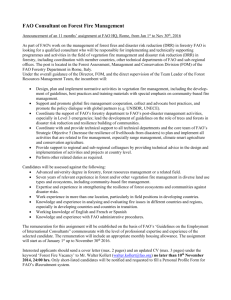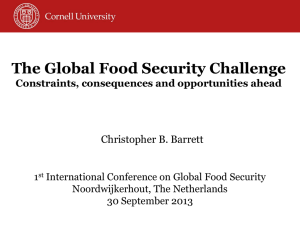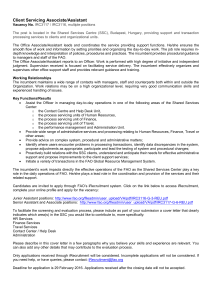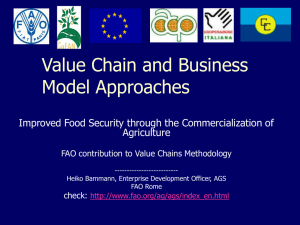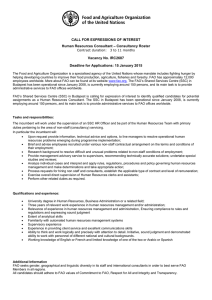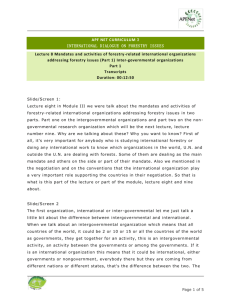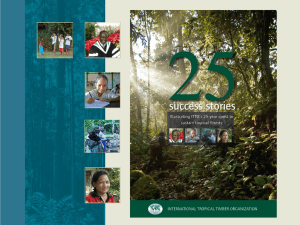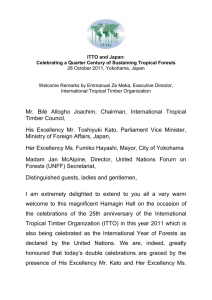4-5 April 2006
advertisement
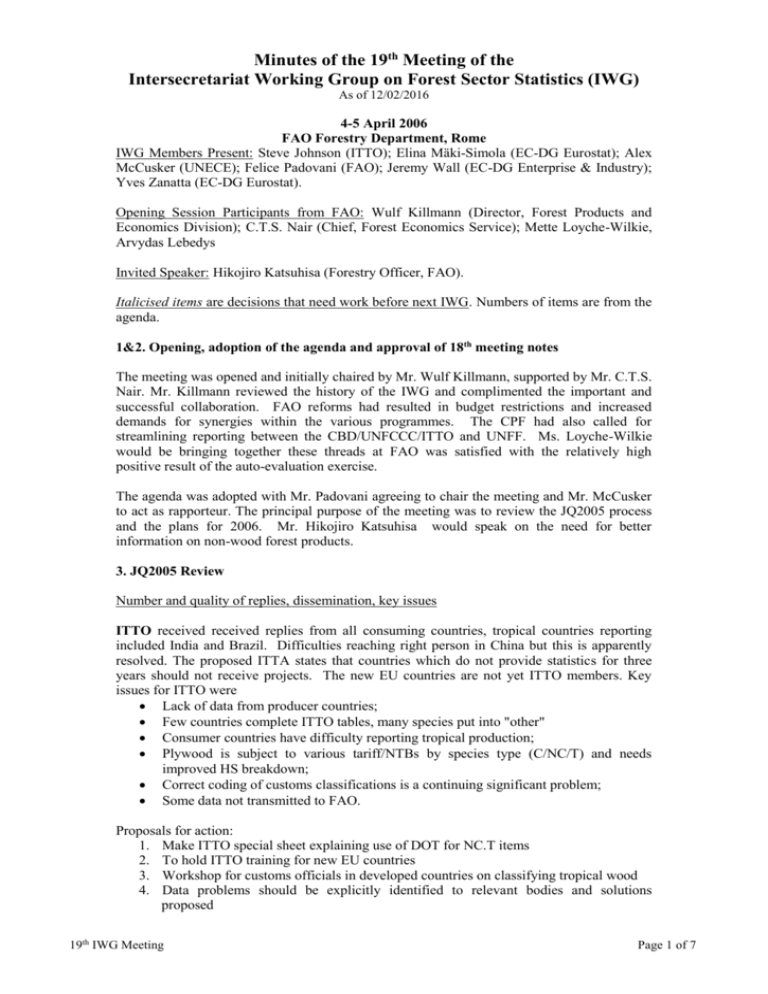
Minutes of the 19th Meeting of the Intersecretariat Working Group on Forest Sector Statistics (IWG) As of 12/02/2016 4-5 April 2006 FAO Forestry Department, Rome IWG Members Present: Steve Johnson (ITTO); Elina Mäki-Simola (EC-DG Eurostat); Alex McCusker (UNECE); Felice Padovani (FAO); Jeremy Wall (EC-DG Enterprise & Industry); Yves Zanatta (EC-DG Eurostat). Opening Session Participants from FAO: Wulf Killmann (Director, Forest Products and Economics Division); C.T.S. Nair (Chief, Forest Economics Service); Mette Loyche-Wilkie, Arvydas Lebedys Invited Speaker: Hikojiro Katsuhisa (Forestry Officer, FAO). Italicised items are decisions that need work before next IWG. Numbers of items are from the agenda. 1&2. Opening, adoption of the agenda and approval of 18th meeting notes The meeting was opened and initially chaired by Mr. Wulf Killmann, supported by Mr. C.T.S. Nair. Mr. Killmann reviewed the history of the IWG and complimented the important and successful collaboration. FAO reforms had resulted in budget restrictions and increased demands for synergies within the various programmes. The CPF had also called for streamlining reporting between the CBD/UNFCCC/ITTO and UNFF. Ms. Loyche-Wilkie would be bringing together these threads at FAO was satisfied with the relatively high positive result of the auto-evaluation exercise. The agenda was adopted with Mr. Padovani agreeing to chair the meeting and Mr. McCusker to act as rapporteur. The principal purpose of the meeting was to review the JQ2005 process and the plans for 2006. Mr. Hikojiro Katsuhisa would speak on the need for better information on non-wood forest products. 3. JQ2005 Review Number and quality of replies, dissemination, key issues ITTO received received replies from all consuming countries, tropical countries reporting included India and Brazil. Difficulties reaching right person in China but this is apparently resolved. The proposed ITTA states that countries which do not provide statistics for three years should not receive projects. The new EU countries are not yet ITTO members. Key issues for ITTO were Lack of data from producer countries; Few countries complete ITTO tables, many species put into "other" Consumer countries have difficulty reporting tropical production; Plywood is subject to various tariff/NTBs by species type (C/NC/T) and needs improved HS breakdown; Correct coding of customs classifications is a continuing significant problem; Some data not transmitted to FAO. Proposals for action: 1. Make ITTO special sheet explaining use of DOT for NC.T items 2. To hold ITTO training for new EU countries 3. Workshop for customs officials in developed countries on classifying tropical wood 4. Data problems should be explicitly identified to relevant bodies and solutions proposed 19th IWG Meeting Page 1 of 7 Dissemination: Publishing 2005 Annual Review by April Data calculations are used for vote and budget allocations Seeking to improve website dissemination ITTO sends raw data to FAO, FAO creates a file and compares with ITTO calculations and flags 10% differences. ITTO does not review post-panels data (items 7 and higher). Eurostat received a good set of responses from the 29 countries (EU25+EFTA) JQ1 - 28 JQ2 - 27 (missing Ireland) SP1 - improved over 2004 Key issues were the deadlines of mid-May and mid-August and the accuracy of the data. There is a political obligation to produce totals for EU-25, thus needing data from all countries for these tables. Confidentiality problems are of increasing importance. This is highly regulated by national statistical offices and Eurostat rules. Some proposed solutions are to get earlier years from professional associations and to aggregate countries into subregional groups. Other problems are the uncertainty created by "0" (missing data or really 0) and by unclear currency units. Work was split between Elina (EU15) and Yves (EU10). Dissemination is through free database (missing some products), no quarterly paper publications. Forest Pocketbook is to be published in 2006. ECE reported generally good responses. Data dissemination went fairly well. There seems to be an increasing demand for better documented data, sources and flags being explained. FAO reported that they had a total of 100 responses for 2005. Problems continue to be missing subitems. Dissemination continues through the on-line database, the Forest Products Yearbook and the CD. FAO had attended the Hannover Wood Fair and explained the context of the FAO work and its relationship to the industry. Major issues were the need to improve error checking in the form and, as usual, the necessity of finding the right correspondents. Improving Existing Data The SP1 data will be published at FAOSTAT, starting with the year 2000. They will consider populating missing countries with COMTRADE data. ITTO pointed out that they use COMTRADE data for items not covered in SP1. The ECE planned to confirm with the Joint Working Party on Forest Economics and Statistics (JWPFES) the continued interest in SP1. Ms. Loyche-Wilkie presented the extensive work done for FRA2005. Differences with the JFSQ were the overbark (FRA) vs. underbark (JFSQ) measurement of removals, 3-year averages versus single years, no differentiation between roundwood and industrial roundwood at FRA, JFSQ asks for all trees outside forest, FRA limits to forest and other wooded land. The IWG felt that the JFSQ definitions were appropriate and suggested FRA should use adjusted JQ data in the future. Of the 187 countries prepared for FRA, 92 relied on the FAOSTAT data while 95 used other sources. These other sources, when compared with FAOSTAT, showed big differences 19th IWG Meeting Page 2 of 7 (>50%) in 39 cases, less significant differences in 51 cases and for 5 countries the data did not exist in FAOSTAT at all. Of the 39 significant differences 24 were in roundwood and 30 were in fuelwood. Each country in FRA is accompanied by a study which could be used by us to complete JFSQ data where these do not otherwise exist. FAO asked IWG members to review data from those countries with significant differences to the JFSQ, to make use of the network of contacts built up during the exercise, and to ask countries to comment on the data. FAO RWE figures should be checked against those used by UNECE. FAO presented data on negative apparent consumption and asked IWG members to seek to reduce this, focusing on cases where this exceeded 10,000 (m3/mt/1000 $). ECE pointed out that "repeated" figures at ECE/EUROSTAT were being translated into FAO "F" (FAO estimate) flag rather than the "T" (repeated trend) flag. Data handling for EU10 This has gone well despite a significant number of changes in correspondents. ECE started supplying 100% of data for its countries to FAO for the years 1998 and later. Eurostat started supplying 100% of data for its countries to ECE (which passes on to FAO) for the years 2000 and later. The new ten accession countries are being supplied by Eurostat starting for the years 2003 and later. Eurostat commented that the EU25 countries should have data going back to 1961 in FAOSTAT (where they exist). 4. FAO Auto-evaluation Evaluated FAOSTAT inquiry logs (with ECE) and a user survey of website. Overall response was that FAO is doing good work, should keep it up and expand to secondary products which represents a significant portion of world wood trade. ITTO agreed, pointing out that SP1 trade was $60 billion, ITTO's SPWP trade was $70 billion. Eurostat and ITTO also underlined the need to improve pre-2000 data for their countries. ECE supported the SP1 data distribution. Pointed out there had been a number of "raids" on the database (from Hamburg and British Columbia) which proved the good use of the system and its stability. Users seem to appreciate the "complementary" role of the data. The IWG agreed to review the SP1 categories to see what significant products might be missed in the current codes. 5. JFSQ 2006 data cycle In general the organizations were happy with the data cycle as done last year so we kept the same dates. Clearly longer time to reply seems to give better results. Agency Dispatch deadline External deadline Internal deadline (last day for new data additions) Basic validation Analytical validation (last day for data corrections) Working system upload 19th IWG Meeting ECE / Eurostat March 31 May 15 June 15 / June 15-Oct 15 ITTO / FAO April 30 August 31 Sep 30 / Nov 20 To June 15 (as received) June 30 / Oct 15 To Sep 30 (as received) July 15 / Oct 30 / Nov 30 June 30-Oct 15 Oct 31 Page 3 of 7 ECE underlined importance of comparing new data with previous data and including an absolute value comparison rather than just relative percentages. A discussion ensued on trying to establish a roundwood-equivalency test. ITTO will send a note describing how they do this. 6. JQ Developments Combining EU3, ECE1 and ITTO2 forms One proposal to use following style IRW Coniferous Sawlog Species Pulp and other IRW Species Comments on the draft proposed during meeting (see attached file) Simplify the section "other" Get rid of "of which" for sawlogs and use if for species FAO suggested using IRW/C/species/wood use Avoid tropical species, keep ITTO2 separate, combining only EU3 and ECE1 HS2007 The IWG estimated that it would take two days to integrate the HS2007 changes into the JFSQ. Eurostat would provide a complete listing of chapters 44, 47, 48 and 94 (along with notes) for the group to work with. Objective would be to have this ready for JFSQ issued in 2008 requesting data for 2007. Tropical plywood trade flows The need to track tropical plywood trade flows in more detail was proposed both by the EC (DG ENTR) and ITTO. NWFP As discussed under item 9, FRA2005 is seeking for information on this. ECE will raise question at JWPFES on what products are of interest. ITTO informed FAO that there were a number of case studies available. We would recommend that any work on definitions of NWFP include HS codes at the 6-digit level and avoid "part of" items. Recovered Wood EU proposes adding recovered wood as a specific item to JFSQ. Primary use is believed for energy. Unfortunately no HS codes that are clearly useable inhibit us from doing this. FAO proposed doing an inquiry on recovered wood. SP1 ITTO includes extra items such as bamboo/can/rattan furniture, wood packaging and broom handles. ITTO will list 6-digit HS codes and associate with each SP1 item or other items on which it collects data. Proposal to compare FAO's 2003 data on SP1 with 2003 data from COMTRADE. Items which use ex-codes would be left blank from COMTRADE. EC (DG ENTR) suggested that production figures for SP1 should also be sought. It seems these would only be valid in value terms. Having production in volume terms and trade in value would, per ITTO, not be helpful anyway. This was discussed but no decision, aside 19th IWG Meeting Page 4 of 7 from postponing to gather more information. Some UNIDO data on output and value-added seemed to have applicability here. Illegal logging EC (DG ENTR) reported briefly on policy developments, notably the EU FLEGT Action Plan, which stressed the need for improved statistical information, not only for measuring illegal logging and its associated trade, but also for monitoring progress of efforts to combat it. FLEGT (Forest Law Enforcement, Governance and Trade) includes: Licensing exports of timber products Partnership agreements The group concluded that the nature of illegal logging made it difficult to collect detailed statistical information. Problems and indicators include: Need definition of illegal logging What needs to be tracked World net trade, imports > exports by 5-10% (CIF/FOB) Negative apparent consumption (not necessarily an indicator of illegal logging but a long trend of missing RW could indicate problems). ITTO believes a step towards a solution is getting good statistics on imports. Wood Energy ECE briefed the IWG on its current activities and forthcoming review by the JWPFES. The EU described official fuelwood statistics as inadequate. The EU biomass action plan called for 80 MTOE (440 million m3). They expressed their support for work being carried out for JWPFES. Conversion factors The IWG reviewed the conversion factors provided by ECE and EU. ITTO pointed out we needed to review conversion factors industry by industry. There are however no resources available at the present to pursue a study of this. 7. Changes to JFSQ Agreed that there were no changes to be done this year. The ITTA would require changes for 2007 data, i.e. in the questionnaire sent out in 2008. Pulp and paper items Detailed breakdown is still good Industry suggests asking for more aggregated data FAO suggests waiting and observing trends for longer time, not going back yet to previous structure No consensus on this issue, we should discuss further with countries. Recovered fibre pulp should be about 20% of recovered paper. It appears that we are missing a fair amount of this. IWG will try to check this during the year on replies received. The cover letter and definitions should be clarified to reflect that we want recovered fibre pulp to be treated on same basis as regular pulp, i.e. not only external sales. IWG members agreed that special attention would be paid to improving negative apparent consumption figures. 8. Meetings and outputs relevant to IWG ITTO ITTA has been agreed Special studies carried out on French and Italian tropical wood use 2004 Annual Review (April 2005) and draft 2005 in November 2005 19th IWG Meeting Page 5 of 7 ECE MIS price bulletin and trade flows 2005 WP Krtiny Workshop on Capacity Building Forest Products Statistics, preliminary and final Secondary Products Trade by Species Forecast information Eurostat February 2006 Working Group Statistics in Focus Free dissemination over internet Quarterly Bulletin has been discontinued FAO No stats meeting Attended Hannover meeting of OES (European Sawmilling Organization) Forest Products Yearbook in hardcopy and PDF Pulp and Paper Capacity survey 2 updates of web database and CD Trends in Wood Products Planned for 2006 FAO/ITTO Joint Workshop for Latin America (September, Santiago Chile) Review response to JFSQ How to find data Introduction to JFSQ Joint Forest Reporting (CBD, ITTO, FAO with UNEP, WCMC, UNFCCC, Desertification) Joint FAO/UNECE Working Party on Forest Economics and Statistics (May, Geneva) Team of Specialists on Sustainable Forest Management in CIS Kotka V (June, Finland) All CPF members FRA advisory group What to collect for FRA2010 and how FAO will do recovered paper survey (tri-annual) Eurostat plans to work on Forestry accounts Forest action plan JRC management of information MCPFE report - Hamburg Advisory Group EC (DG ENTR): EU Energy “Megapackage”foreseen for second half of 2006 with big renewable componebt, esp. follow-up on EU Biomass Action Plan DG ENV Forestry unit amalgamated into other units, with EC coordination for UNFF, passing to the International Relations Unit of DG Environment DG Agriculture has replaced the Forestry and Environment unit with a Forestry, Biomass and Rural Development unit Forest Action Plan 2007-13 being established by DG AGRI. 19th IWG Meeting Page 6 of 7 The new ITTA (2006) will take effect in February or October 2007, will run for 18 years. Penalties for failure to provide data Includes some tropical items as coniferous Reviews will be bi-annual with no need for ITTO questionnaires in off-year Administrative budget is split 60/40 between consumers and producers Increased administrative budget to $8 million Personnel movements EU Forestry Statistics currently has 2 1/2 people working. ECE, following reorganization of department, has a P2 joining unit. ITTO is replacing its statistical assistant and recruiting a systems analyst, Steve Johnson will be working on the broader area of communications. FAO is unifying its FRA and FPS and institutional work into new programme element unifying all country-based elements, coordinated by Mette Wilkie-Loyche under Wulf Killman in the Forest Products Division. There are a total of 15 program elements in forestry with three in forest products. Education/extension has been abolished and there will be more regional offices. 9. Non-wood forest products/non-timber forest products Mr. Katsuhisa (FOPO, Forest Products and Economics Division) discussed the significance and interest of NWFP/NTFP. Forest security, income generation Products such as moss, ferns, barks and leaves Lack of quantitative information No classifications Many local problems Recent study from Cameroon covering 300,000 ha EFSOS claimed 25% of wood removal was non-timber Example of Japan where mushroom industry was equivalent to half of forest industry. In FRA2005 they asked for information on 8 plants and 8 animals. Only 1/3 of countries were able to respond and replies were difficult to analyse. Key areas for FAO were: Improving methodologies Support institutional capacity Strengthen global network Promote best practice. FAO planned to lauch partnership at WFC in Argentine. Planned outputs for 2006/2007 are o Trade analysis o Key subjects (certification, organic) o 2 issues / year of Non-wood news ITTO commented on the need to look downstream in this area, EU was interested in employment levels (formal/informal), 19th IWG Meeting Page 7 of 7

